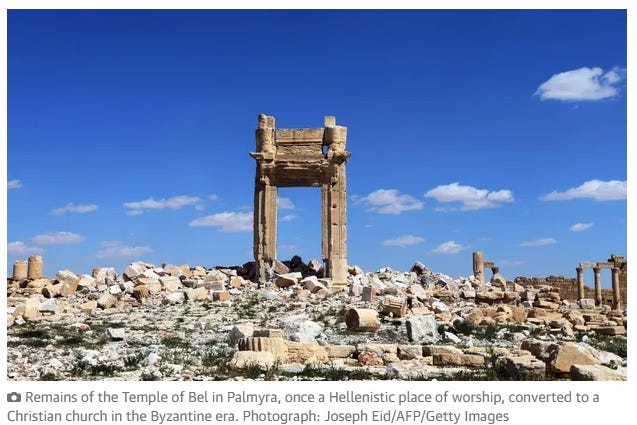Chapter 9 - LPG in Retirement and Death, Muscular Christians Destroy Temples, Roe v. Wade
FbF Book Club: The Final Pagan Generation (Watts, 2015)
Previous Entry - Chapter 8: Generational Change and Absorption of the New Christian Elites
If you were around in the early and mid 1980s, you will remember how the West used to mock the USSR for its “gerontocracy” (rule by the elderly). Brezhnev gave way to Andropov, who lasted barely two years before giving way to a very sickly-looking Chernenko, himself lasting only a year or so. Mocking this Soviet Gerontocracy worked, as it symbolized a country that was stagnant, led by an ideology that was uncompetitive and all out of ideas. Cernenko’s successor, Mikhail Gorbachev, injected fresh blood into the Politburo (he was only in his 50s when got into power), but by that time it was too late, and the USSR would fall apart less than a decade later.
Joe Biden is turning 80 this November, and his presence in front of the camera betrays noticeable cognitive decline. Mitch McConnell turned 80 this past February. Nancy Pelosi is 82. Chuck Schumer is a sprightly 72. Donald Trump will be 78 years old if he runs in 2024. I don’t think it’s unfair to characterize the political leadership of the USA today as a gerontocracy.
The penultimate chapter in Watts’ The Last Pagan Generation opens up with a peek at how 4th century Rome looked upon the elderly at the time. Human nature being what it is, we see that the young sought to clear out the dead wood in order to grab their positions in the imperial administration for themselves. We also see how some of the Last Pagan Generation nevertheless continued to work on behalf of the Emperor, whether in an official capacity or by way of tapping into their own influence with the court through their long-established and well-entrenched networks. Unlike today’s USA, late 4th century Rome was not a gerontocracy:
Although we often think of the senate and city councils as bastions of elderly, experienced former magistrates, they were actually bodies made up primarily of young and middle-aged men. The minimum age for membership in the Roman senate in the imperial period was twenty-five. In the high empire, 14–16 percent of the senate was between twenty-five and twenty-nine years old, and an additional 25–28 percent was between thirty and thirty-nine. By contrast, only 11–13 percent was between sixty and sixty-nine, and perhaps as little as 5 percent was over age seventy.14 The Constantinopolitan senate before which Themistius rose in 383 would have been even younger, as Theodosius’s ongoing efforts to build its membership up to two thousand inevitably drew in primarily younger men.15 Probably more than 90 percent of Themistius’s audience in 383 was made up of men younger than him.
Libanius, from the eastern half of the empire, plays the star in this chapter, as not only was he involved up imperial affairs right up to his death, but also because so many of his letters and orations survive to this day. Others, like Themistius, once the shining star in the court at Constantinople, were so openly mocked for their age that they chose to withdraw from public life entirely. To each his own.
Watts’ methodology of tracking the lives of these four powerful Romans of the Last Pagan Generation through the changes of the 4th century has borne a lot of fruit, nowhere more so than in this chapter, despite it entirely relying on Libanius. In my opinion, this is due to the impression left with us that Libanius was content in the days leading up to his death that he managed to successfully serve the empire throughout his life, while maintaining the system of privileges, favours, and rewards that came with it. Consensus and balancing acts had won out (he thought), with excesses tamed due to influence with Emperors. He lived like he died: a system loyalist.
What we have seen thus far is that this generation was too busy accumulating personal wealth and pursuing career interests and influence to notice the existential threat that an increasingly muscular Christianity presented to the Empire that they were used to. In the last chapter we saw how Ambrose of Milan began for the first time to flex the power of the Christian Church by openly threatening the Empire itself. Libanius, Themistius, and Ausonius were certain that the system could meet the challenge by the time they noticed it. I would like to draw a parallel here between them and the establishment conservatives of today’s USA, a type that is convinced that arguments and appeals to the US Constitution are all that is needed, despite them ceding so much institutional power to the progressives, much like how 4th Century Rome granted increasing institutional power to the Christians. System loyalty and misplaced self-confidence?
The Riot of the Statues
Two entries ago, we surveyed the rise of the Christian counterculture, one that spread like wildfire in both halves of the Roman Empire, capturing a large segment of the elite youth. Either taking up positions in the Church or completely dropping out of society to pursue asceticism, many began to re-enter the Roman administration and work on behalf of the Christianization of the Empire.





